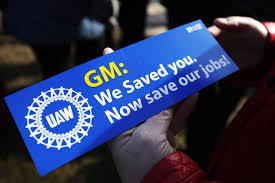
(BEDFORD) – The longest General Motors strike in history is over and workers in Bedford returned to work today.
The United Auto Workers union voted in favor of a four-year labor deal to end the walkout.
The United Auto Workers union released a statement announcing that UAW General Motors members ratified the 2019 Collective Bargaining Agreement on Friday.
The rank-and-file members voted 57 percent in favor of the deal, according to the union. Locally, the 703 members of UAW Local 440 voted 60 percent to 40 percent not to approve the terms of the agreement, according to union president Kevin Hutchinson.
The vote ends a painful work stoppage that has lasted six weeks, costing GM nearly $2 billion in lost production and employees nearly $1 billion in lost wages.
The final deal is hardly a victory. In fact, the tentative four-year contract would give striking workers four small wins and one major loss.
Workers are guaranteed a 3 percent pay raise and a 4 percent lump-sum increase in alternating years. Employees got the same result the last time they negotiated a contract in 2015, without going on strike. GM agreed to lift the $12,000 cap on profit-sharing, so there’s no limit to the cut workers can get from GM’s profits. Right now, they each get $1,000 for every $1 billion the company earns.
The Detroit-Hamtramck factory was one of four slated for closure before the strike, it will now stay open, and GM will build electric trucks and vans there. That’s a $3 billion investment in 2,225 jobs. The company will also invest $1 billion in two other factories — one in Tennessee and another in Michigan — to build mid-size SUVs.
There is now a process for temporary workers to become permanent employees after three years on the job and for newer hires to earn the full pay rate in four years instead of eight. That top wage rate was increased from about $30 to $32 per hour.
The cost of workers’ health care plans, among the lowest in the nation, was left untouched. The company had announced plans to increase premiums but backed down during the strike.
Permanent workers will also get an $11,000 signing bonus and temporary workers will get $4,500 – basically it covers the wages they lost during the strike.
Union negotiators were unable to get GM to move car production from Mexico to the Lordstown, Ohio plant, which once produced the Chevy Cruze, which was perhaps the most sensitive issue on the table. It was terrible news for the 1,400 workers who have since been laid off – several hundred of them have accepted transfers to other factories. GM officials have promised to open an electric car battery factory near the Lordstown plant. That’s not what the union wanted, though, because it would only employ a few hundred people at lower wages.
The strike by nearly 50,000 hourly GM workers started Sept. 16. It is the largest against a US business since the last GM strike 12 years ago. But that strike was over in less than three days. This strike is the longest auto industry work stoppage in more than 20 years and the longest nationwide auto strike in 50 years.



